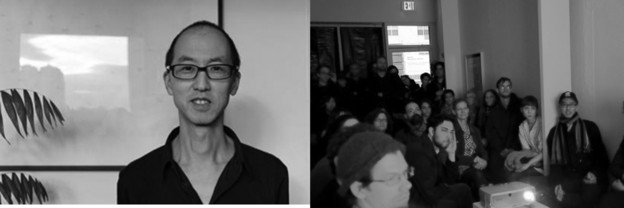Why Power Point?
A question for Tan Lin

Installment 2 of “WHY?” in which I ask certain people Why questions and they answer in 100-300 words. Beside Trisha Low, the other first person I had a Why question for was Tan Lin. I have been enthusiastic for years about his genre-diffusing, multi-platformed work under the auspices of poetry. For the last several years each new work from Lin operates like a "demo" that stages an exchange between various genres and platforms. Some of the demos use digital inputs to test the platform of the book, as in one reading of his book Heath Plagiarism/Outsource. In his Power Points films, "Bibliographic Soundtrack" and "The Ph.D. Sound," it's the other way around. Lin is taking what he can of particular genres, most recognizably poetry, film, and bibliography, and testing the limits of what can be done applying them to each other as strategies in the (constrained?) world of Power Point. After attending two screenings of his ppt films, I felt both amused and perplexed. Surely it must be a joke that he's trying to make a film out of words, or a bibliography with a beat, using a platform everyone agrees has acheived full brand recognition for its particular form of boring. Did he think it was as much of a joke as I did, was this all a bit tongue-in-cheek, or did he actually like Power Point? So I asked him: Why Power Point? Here’s his answer.
PPT allowed me to diffuse a book into a general operating system, in this case a specific and much maligned genre of office productivity software. People complain about PPT hell, but I wanted something slow, porous and meditational. Of course, during a PPT presentation, people do get up and walk out. People want to control their own attention. But I think it’s more interesting to give oneself over to something. Excitement in a book is generally over rated. If reading is a (very loose) pattern of information control, the PPT pieces marshal a lot of multimedia devices: overhead transparency, photographic slide, filmic dissolve, soundtrack—to contain a data flood. Most of the textual material was lifted from communications rather than literary mediums: Tumblr sites, Twitter feeds, RSS, IM, video game walkthroughs, indexes, tables of plates, and public domain bibliographies. All this floods the space of a reading and maybe it congeals into a reading—or not. Can reading be a highly generalized architecture or geography? I think so; here PPT architecture is explicitly multi-media in nature: it “behaves” filmically and photographically; it resembles a status update or IM thread; it materializes like a screen title, and it erases itself, one slide/page (at fixed intervals). In short, it resembles reading we do on devices or in web 3.0. When you read a book, the text is generally not moving, or reading itself. But this is not true with a cell phone—or PPT.
This is nothing new. Homer’s Odyssey conveyed historical data. Ezra Pound’s injunction to make it new in re-versioned primers such as his ABC of Reading link poetry to news dissemination. Eliot’s Four Quartets were written in a more universal, “musical” language that bears a close relation to Eliot’s wartime radio broadcasts over the BBC and German radio—familiar, comforting, and blandly generic. You have to remember too, that when Eliot’s The Waste Land was first broadcast in 1937 over the BBC most of the people at the radio station did not know who he was; he was still a minority literary figure unlike someone like H.G. Wells—who as Eliot noted, came out of entertainment and who also made use of the radio.
With the two PPT works, you have two key residual formats, which I associate with the “literary” or the “academic”: book and lecture, i.e. you have either a captive or a less captive audience. People tend to ignore PPT for the wrong reasons. My simple query was: what happens when a book is diffused into the genre known as an office suite or the authoring functions behind integrated software? Or to put it more succinctly: what would be the most generalized, generic and medium-unspecific “reading” you could get? Thus the reading is and is not very PPT. It’s weak didactically! It lacks a point! What is a reading anyway? At Artists Space we perfumed the reading of BST with a Glade White Linen Air Stick, Chris Brosius’ Wet Pavement London and a copy of Ernst Fenellosa’s Epochs of Chinese Painting that I borrowed from my mother’s library. What’s a book? A lot of borrowed stuff. In this case I wanted something like a book and in PPT to be diffused around its readers—like a perfume.
Genres condition reading and genres (take sheep herding poetry) wear out, and they do so in particular mediums. When was the last time you read an eclogue or a bucolic by Theocritus? Georgian war poetry circa 1904 feels irrelevant today, but so does lyric poetry in the Paris Review. Computational poems in PPT, where the genre known as the PPT presentation dissolves into something literary—that may be another matter. Milton’s Lycidas is notably mixed; it splits pastoral with elegy, and before it’s done the form threatens to turn itself inside out. It’s not surprising that today, instead of the pantoum, we have the Tumblr log or mixed verse of Powerpoint. How does the PPT poem end? I’m not sure we know yet.
Notes
• "Eliot on the Air: 'Culture' and the Challenges of Mass Communication," in Time Present and Time Past: T.S. Eliot and Our Turning World, ed. J.S. Brooker (Macmillan, 1999)
• "The European Radio Broadcasts of T.S. Eliot," (Miscellanea 20, 1999)
Check out video footage from the event Power Point and the Perfume of Reading
Check out Lin's Power Point recordings and other works
Gossip or history